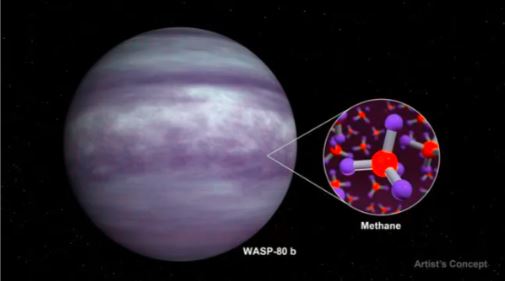The James Webb Space Telescope (JWST) has detected methane and water vapor in the atmosphere of WASP-80 b, a Jupiter-like exoplanet located about 163 light-years away. This marks a marked advancement in the study of exoplanetary atmospheres.
Astronomers, including a team from Arizona State University and the Bay Area Environmental Research Institute, used JWST’s powerful infrared capabilities to observe WASP-80 b transit across its parent red dwarf star.
This exoplanet completes an orbit roughly every three Earth days. While water vapor has been identified in the atmospheres of about a dozen planets, the detection of methane – standard in the atmospheres of solar system giants like Jupiter and Saturn – has been rarer. (https://shlohmo.com)
“This was the first time we had seen such an obvious methane spectral feature in a transiting exoplanet spectrum,” said scientist Luis Welbanks.
Previously, JWST had discovered atmospheric methane around exoplanet K12-18b, but the clarity of this new detection is unprecedented.
Classified as a “warm Jupiter,” WASP-80 b is not as close to its star as “hot Jupiters” but is still more intimate than “cold Jupiters” like our solar system’s Jupiter.
James Webb Space Unveils WASP-80 b Atmosphere Mysteries

The challenge of differentiating WASP-80 b from its star is formidable, akin to spotting a human hair from 9 miles away.
However, astronomers have successfully used the transit method, observing the planet as it passes before its star, causing a measurable dimming of starlight.
The team also measured thermal radiation emitted by the planet, considering its surface temperature of 1,025 degrees Fahrenheit. The data from the transit and eclipse helped the scientists simulate the planet’s atmospheric conditions, confirming the presence of methane.
This discovery sheds light on WASP-80 b formation and evolution and contributes to understanding the atmospheric composition of giant planets.
It also allows for comparing exoplanetary atmospheres with those of solar system giants, using data from missions to Jupiter and Saturn.
Welbanks notes the importance of methane in both atmospheric chemistry and as a potential biological signature.
This research, published in Nature, paves the way for future missions to search for life-sustaining gases like oxygen and methane on Earth-like planets.
This influential find by JWST underscores the telescope’s role in enhancing our knowledge of the universe, bringing us closer to understanding distant worlds and their potential to harbor life.


Comments are closed.